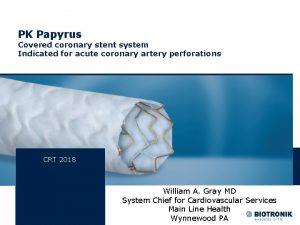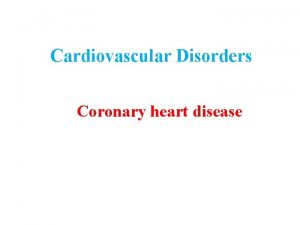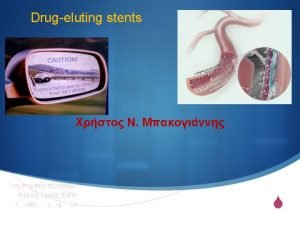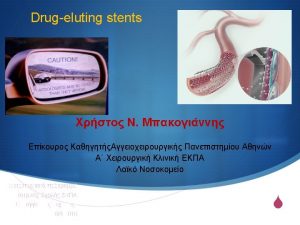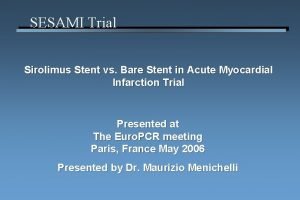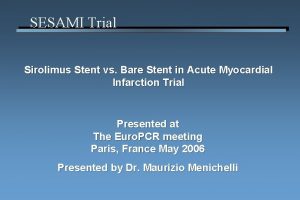Coronary Stent Megan French What is a Stent









- Slides: 9

Coronary Stent Megan French

What is a Stent • A small, mesh-like device made of metal • Acts as a support or scaffold, in keeping the vessel open • Stent helps to improve blood flow to the heart muscle and reduce the pain of angina • 80% of patients who have balloon angioplasty will have a stent placed as well.

Types Bare metal stents: – Traditional method – May have an increased rate of re-narrowing due to growth of scar tissue in the stent, a condition called Restenosis. Drug-eluting stents: -Combat Restenosis - Coated with medications that are slowly released to block the body's ability to form scar tissue around the stent. The medication is delivered directly to the site of the artery blockage.

History • Percutaneous transluminal coronary angioplasty (PTCA) by Gruntzig in 1977 • Puel and Sigwart, in 1986, deployed the first coronary stent to act as a scaffold • In 2001, drug-eluting stents (DES) were introduced as a strategy to minimize restenosis

Procedure • First a catheter is inserted in the groin or arm. After the catheter is in place a wire will be guided through the artery until it reaches the blockage in the heart. A soft, flexible catheter tube will be slipped over the wire and threaded up to the blockage. • The doctor will be taking x-ray pictures during the procedure and dye will be injected into the arteries of your heart. • Once the blockage is reached, a small balloon at the tip of the catheter will be rapidly inflated and deflated. This will stretch the artery open. • The collapsed stent will be inserted. The balloon will be inflated again to expand the stent to its full size. The stent will be left in place to hold the vessel walls open. The deflated balloon, catheter, and wire will be removed.


Future Advancements • The Re. Zolve™ stent integrates a proprietary drug-eluting polymer and a novel design to create a stent with metal-like performance out of a polymer material. • The stent restores blood flow and supports the artery through healing, then completely dissolves from the body, leaving the patient free of a permanent implant.

Future Advancements • Unlike permanent metal alloys, the REVA polymer dissolves from the body after healing of the artery has occurred, leaving additional treatment options available in the future. • Another unique feature of the polymer is that it is visible under x-ray, allowing the stent to be visualized during the implant procedure and at follow up. Other bioresorbable polymer stents are invisible and require permanently attached radiopaque markers to aid in their placement.

References • J Am Coll Cardiol, 2000; 35: 1288 -1294 © 2000 by the American College of Cardiology Foundation • Maria Alexandra Rodriguez, David L Fischman, Michael P Savage. (2010) Advances in vein graft intervention. Interventional Cardiology 2: 5, 735 -754 • Masahiro Jinzaki, Minoru Yamada, Yutaka Tanami, Sachio Kuribayashi. (2011) Evaluation of In-Stent Restenosis by High Spatial Resolution CT. Current Cardiovascular Imaging Reports • http: //texasheart. org/HIC/Topics/Proced/angioplasty. cfm • http: //www. nhlbi. nih. gov/health-topics/stents/ • J. Am. Coll. Cardiol. , November 7, 2011; (2011) j. jacc. 2011. 08. 007 v 1. • Serruys PW, Kutryk MJB, Ong ATL. Coronary-artery stents. N Engl J Med 2006; 354: 483 -95.

